Global Financial Crisis and Quantitative Monetary Easing Policy in UK
VerifiedAdded on 2023/06/16
|14
|2028
|197
Report
AI Summary
This report critically evaluates the impact of the global financial crisis and the ongoing quantitative easing (QE) monetary policy in the United Kingdom. It begins by outlining the effects of the 2008 financial crisis on the UK, highlighting the decline in consumer confidence, reduced economic growth, and rising unemployment. The report then examines the key sectors of the UK economy and their contributions, as well as the nation's sources of comparative advantage. An analysis of the UK's balance of payments, including trade balance, current account balance, and capital flows, reveals persistent deficits and reliance on foreign investment. The report further discusses the implementation of quantitative easing by the Bank of England, noting its initial positive impact on GDP and inflation, but also its subsequent contribution to a low inflation environment. The report concludes that while QE initially aided economic recovery, alternative strategies are now needed to boost the UK economy. Desklib provides students access to this document and many more solved assignments and study resources.
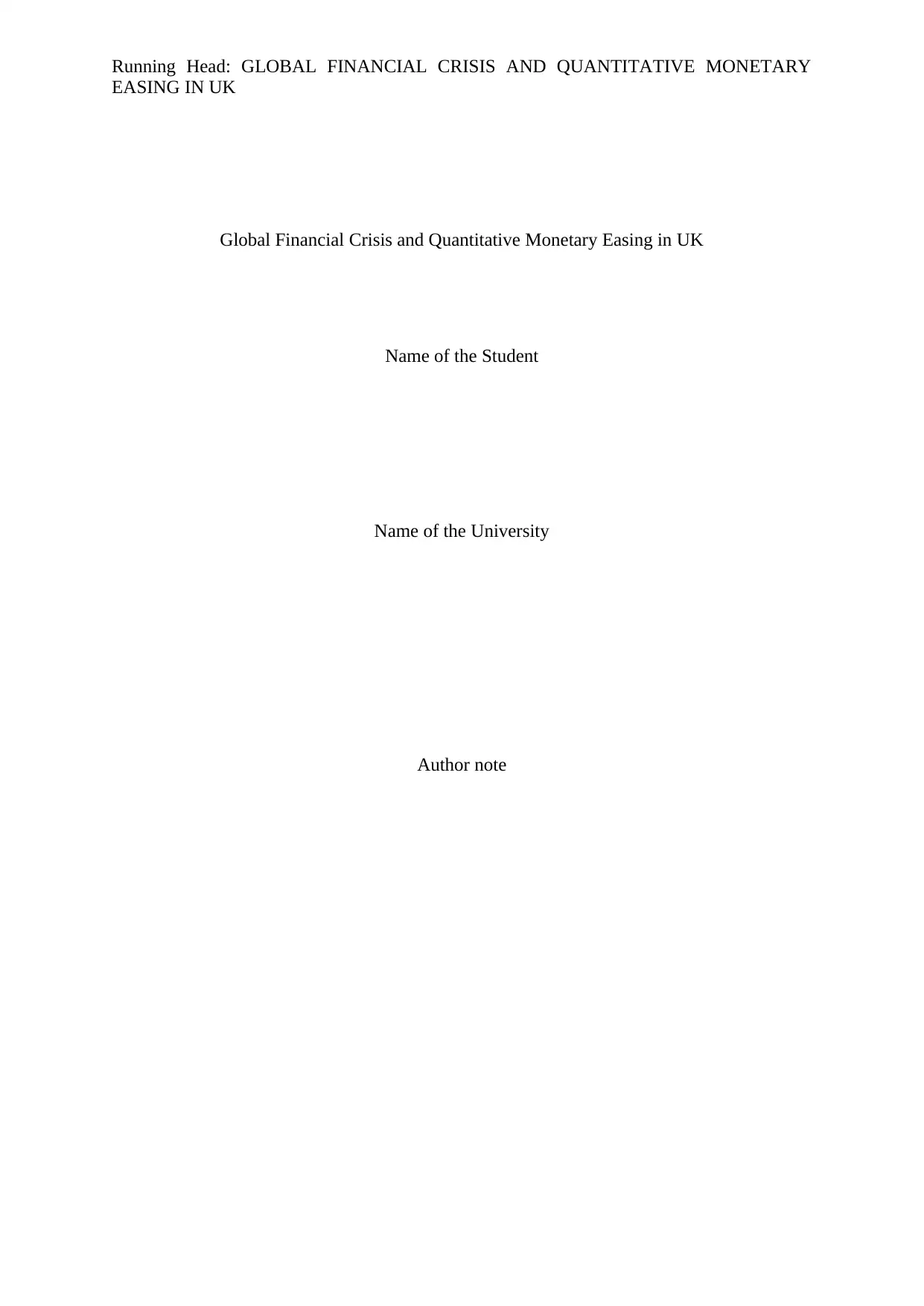
Running Head: GLOBAL FINANCIAL CRISIS AND QUANTITATIVE MONETARY
EASING IN UK
Global Financial Crisis and Quantitative Monetary Easing in UK
Name of the Student
Name of the University
Author note
EASING IN UK
Global Financial Crisis and Quantitative Monetary Easing in UK
Name of the Student
Name of the University
Author note
Paraphrase This Document
Need a fresh take? Get an instant paraphrase of this document with our AI Paraphraser

1
GLOBAL FINANCIAL CRISIS AND QUANTITATIVE MONETARY EASING
IN UK
Table of Contents
Introduction................................................................................................................................2
Global Financial Crisis and impact on UK................................................................................2
Important Sectors of UK economy and their contribution.........................................................3
Sources of Comparative advantage in UK.................................................................................3
Dynamic of change in the nation’s comparative advantage.......................................................4
Analysis of Balance of Payment................................................................................................8
Trade Balance of UK.........................................................................................................8
Current Account Balance...................................................................................................9
Flow of capital in UK.........................................................................................................9
Quantitative easing monetary policy in UK.............................................................................10
Conclusion................................................................................................................................11
References................................................................................................................................12
GLOBAL FINANCIAL CRISIS AND QUANTITATIVE MONETARY EASING
IN UK
Table of Contents
Introduction................................................................................................................................2
Global Financial Crisis and impact on UK................................................................................2
Important Sectors of UK economy and their contribution.........................................................3
Sources of Comparative advantage in UK.................................................................................3
Dynamic of change in the nation’s comparative advantage.......................................................4
Analysis of Balance of Payment................................................................................................8
Trade Balance of UK.........................................................................................................8
Current Account Balance...................................................................................................9
Flow of capital in UK.........................................................................................................9
Quantitative easing monetary policy in UK.............................................................................10
Conclusion................................................................................................................................11
References................................................................................................................................12

2
GLOBAL FINANCIAL CRISIS AND QUANTITATIVE MONETARY EASING
IN UK
Introduction
In the world economy United Kingdom is considered as one of the leading power in
global trade. The nation has a strong financial sector. Following Germany and France it is the
third largest European economy. The nation possesses an intensive agricultural sector that
meets 60 percent of the nation food demand. Insurance, banking and business services are
main drivers of UK’s economic growth. In the phase of global financial crisis in 2008, the
economy was severely affected because of its heavy reliance on the financial sector. In order
to combat crisis the fiscal and monetary policy stimulus taken by different nations that lead to
another round of crisis in 2011. The paper critically evaluates impact of recent global
financial crisis and the ongoing quantitative easing monetary policy in UK.
Global Financial Crisis and impact on UK
First phase of the global financial crisis began on September 2007. This is the time
when banking system in United States ceased to supply funds to the mortgage debt. This
financial crisis finally broke out in September 2008. During this time the invest bank in US
Lehman Brothers went bankrupt. The incident eroded all the faith on banking system. The
flow of credit to the private sector and consumer become restricted reducing the confidence
of business. The G20 group constitute of both developed and developing nations act together
to counter the ongoing recession. In 2010, the focus of European Union switched from
private to public sector. The lower tax rate and high government spending result in huge
fiscal deficit and affect policy decision of UK, nations in the euro zone and United State
(Castells 2014). The shift of private debt to a sovereign debt even worsens the situation. The
policy markers found a slow economic growth and systematic crisis badly affecting European
countries. This is how the crisis that set in 2007, has taken a dangerous form in its new phase.
GLOBAL FINANCIAL CRISIS AND QUANTITATIVE MONETARY EASING
IN UK
Introduction
In the world economy United Kingdom is considered as one of the leading power in
global trade. The nation has a strong financial sector. Following Germany and France it is the
third largest European economy. The nation possesses an intensive agricultural sector that
meets 60 percent of the nation food demand. Insurance, banking and business services are
main drivers of UK’s economic growth. In the phase of global financial crisis in 2008, the
economy was severely affected because of its heavy reliance on the financial sector. In order
to combat crisis the fiscal and monetary policy stimulus taken by different nations that lead to
another round of crisis in 2011. The paper critically evaluates impact of recent global
financial crisis and the ongoing quantitative easing monetary policy in UK.
Global Financial Crisis and impact on UK
First phase of the global financial crisis began on September 2007. This is the time
when banking system in United States ceased to supply funds to the mortgage debt. This
financial crisis finally broke out in September 2008. During this time the invest bank in US
Lehman Brothers went bankrupt. The incident eroded all the faith on banking system. The
flow of credit to the private sector and consumer become restricted reducing the confidence
of business. The G20 group constitute of both developed and developing nations act together
to counter the ongoing recession. In 2010, the focus of European Union switched from
private to public sector. The lower tax rate and high government spending result in huge
fiscal deficit and affect policy decision of UK, nations in the euro zone and United State
(Castells 2014). The shift of private debt to a sovereign debt even worsens the situation. The
policy markers found a slow economic growth and systematic crisis badly affecting European
countries. This is how the crisis that set in 2007, has taken a dangerous form in its new phase.
⊘ This is a preview!⊘
Do you want full access?
Subscribe today to unlock all pages.

Trusted by 1+ million students worldwide
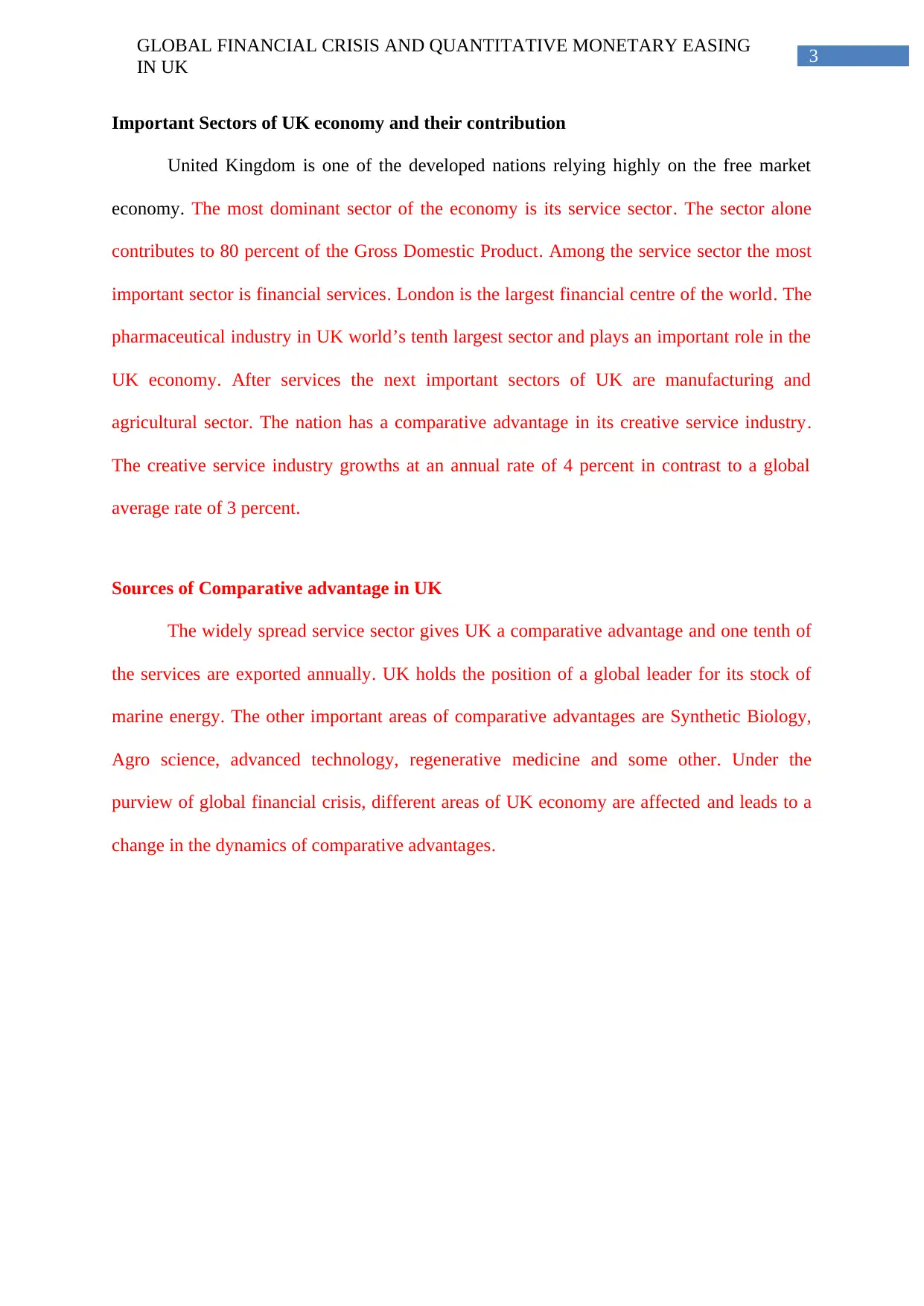
3
GLOBAL FINANCIAL CRISIS AND QUANTITATIVE MONETARY EASING
IN UK
Important Sectors of UK economy and their contribution
United Kingdom is one of the developed nations relying highly on the free market
economy. The most dominant sector of the economy is its service sector. The sector alone
contributes to 80 percent of the Gross Domestic Product. Among the service sector the most
important sector is financial services. London is the largest financial centre of the world. The
pharmaceutical industry in UK world’s tenth largest sector and plays an important role in the
UK economy. After services the next important sectors of UK are manufacturing and
agricultural sector. The nation has a comparative advantage in its creative service industry.
The creative service industry growths at an annual rate of 4 percent in contrast to a global
average rate of 3 percent.
Sources of Comparative advantage in UK
The widely spread service sector gives UK a comparative advantage and one tenth of
the services are exported annually. UK holds the position of a global leader for its stock of
marine energy. The other important areas of comparative advantages are Synthetic Biology,
Agro science, advanced technology, regenerative medicine and some other. Under the
purview of global financial crisis, different areas of UK economy are affected and leads to a
change in the dynamics of comparative advantages.
GLOBAL FINANCIAL CRISIS AND QUANTITATIVE MONETARY EASING
IN UK
Important Sectors of UK economy and their contribution
United Kingdom is one of the developed nations relying highly on the free market
economy. The most dominant sector of the economy is its service sector. The sector alone
contributes to 80 percent of the Gross Domestic Product. Among the service sector the most
important sector is financial services. London is the largest financial centre of the world. The
pharmaceutical industry in UK world’s tenth largest sector and plays an important role in the
UK economy. After services the next important sectors of UK are manufacturing and
agricultural sector. The nation has a comparative advantage in its creative service industry.
The creative service industry growths at an annual rate of 4 percent in contrast to a global
average rate of 3 percent.
Sources of Comparative advantage in UK
The widely spread service sector gives UK a comparative advantage and one tenth of
the services are exported annually. UK holds the position of a global leader for its stock of
marine energy. The other important areas of comparative advantages are Synthetic Biology,
Agro science, advanced technology, regenerative medicine and some other. Under the
purview of global financial crisis, different areas of UK economy are affected and leads to a
change in the dynamics of comparative advantages.
Paraphrase This Document
Need a fresh take? Get an instant paraphrase of this document with our AI Paraphraser
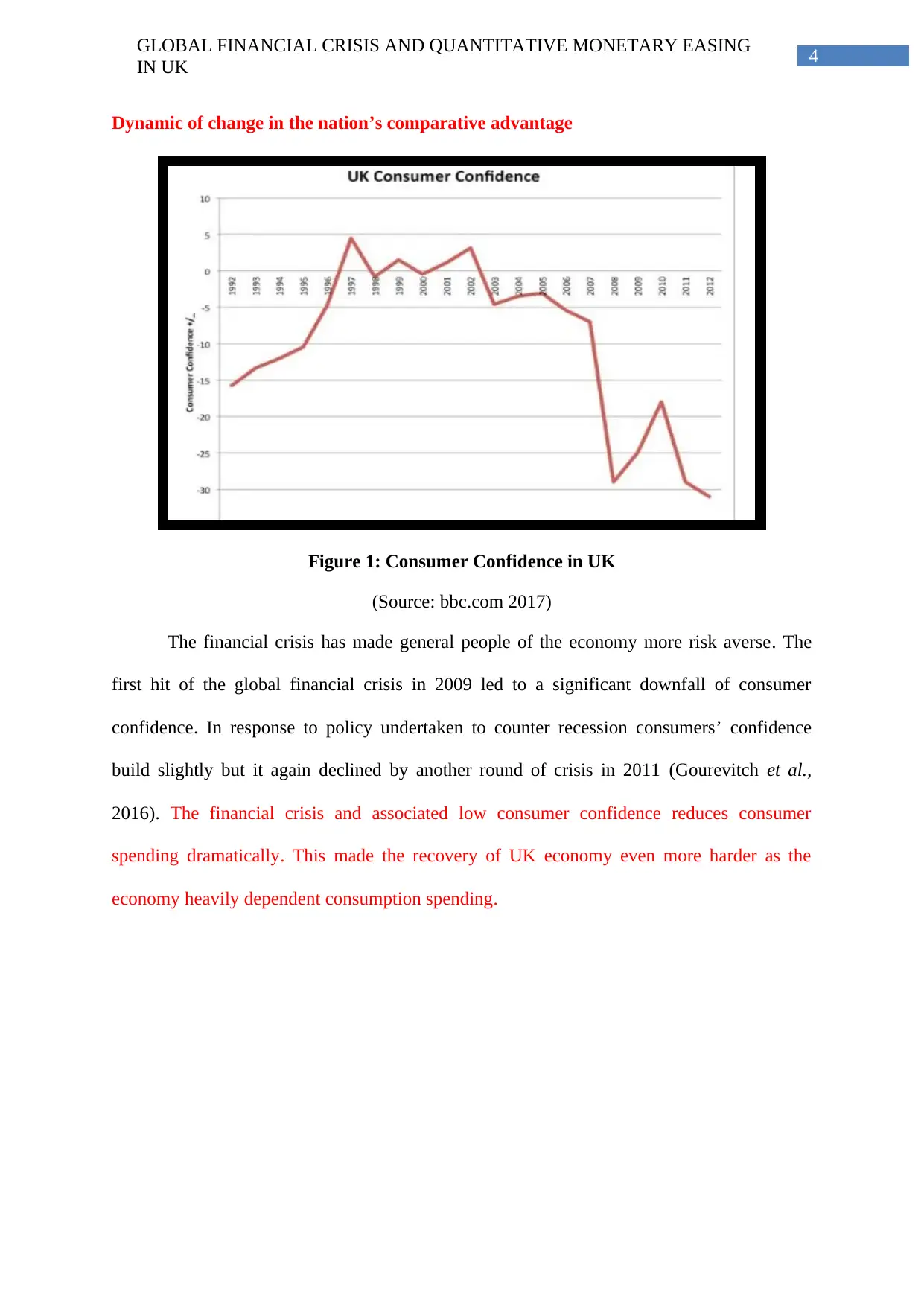
4
GLOBAL FINANCIAL CRISIS AND QUANTITATIVE MONETARY EASING
IN UK
Dynamic of change in the nation’s comparative advantage
Figure 1: Consumer Confidence in UK
(Source: bbc.com 2017)
The financial crisis has made general people of the economy more risk averse. The
first hit of the global financial crisis in 2009 led to a significant downfall of consumer
confidence. In response to policy undertaken to counter recession consumers’ confidence
build slightly but it again declined by another round of crisis in 2011 (Gourevitch et al.,
2016). The financial crisis and associated low consumer confidence reduces consumer
spending dramatically. This made the recovery of UK economy even more harder as the
economy heavily dependent consumption spending.
GLOBAL FINANCIAL CRISIS AND QUANTITATIVE MONETARY EASING
IN UK
Dynamic of change in the nation’s comparative advantage
Figure 1: Consumer Confidence in UK
(Source: bbc.com 2017)
The financial crisis has made general people of the economy more risk averse. The
first hit of the global financial crisis in 2009 led to a significant downfall of consumer
confidence. In response to policy undertaken to counter recession consumers’ confidence
build slightly but it again declined by another round of crisis in 2011 (Gourevitch et al.,
2016). The financial crisis and associated low consumer confidence reduces consumer
spending dramatically. This made the recovery of UK economy even more harder as the
economy heavily dependent consumption spending.
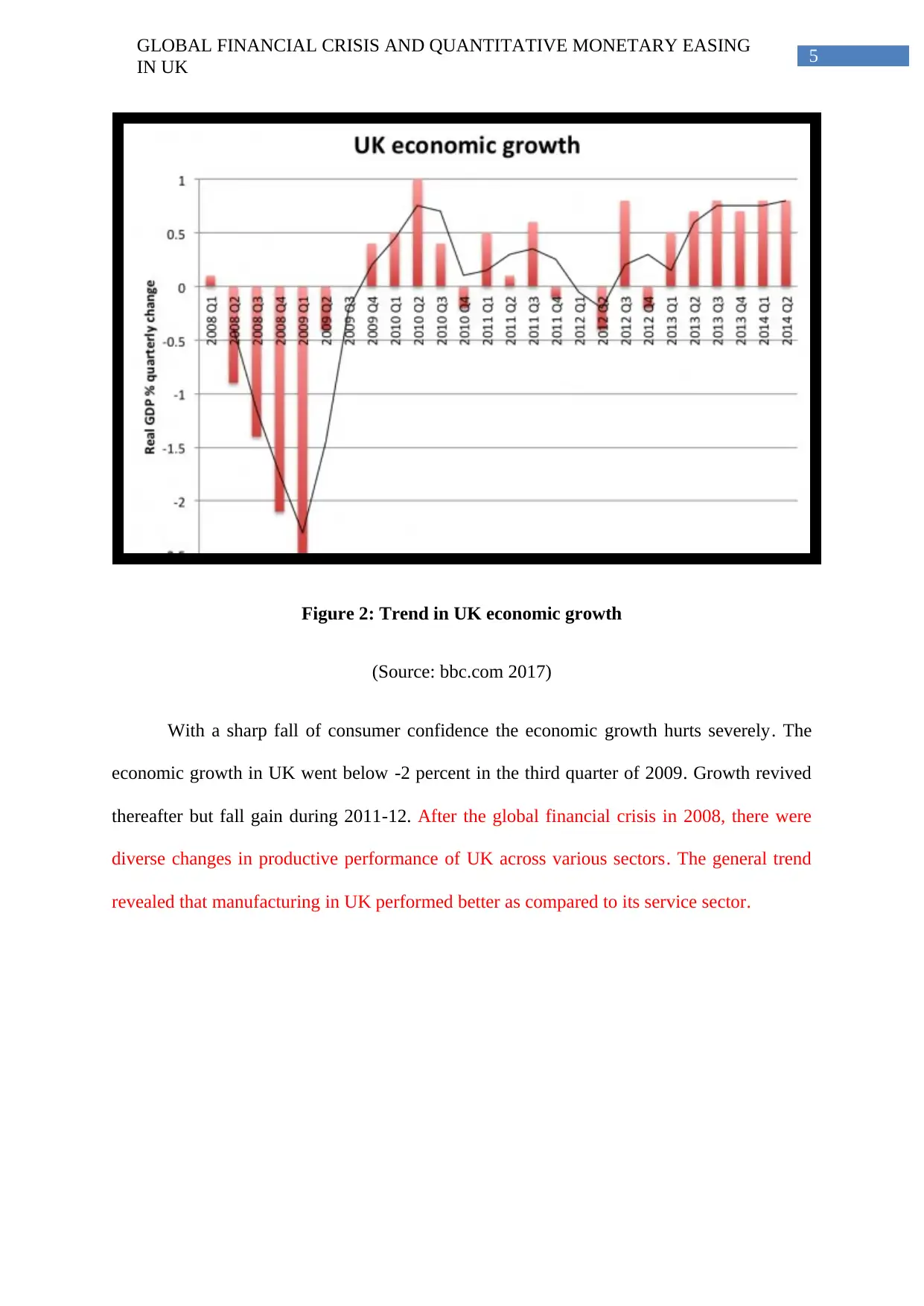
5
GLOBAL FINANCIAL CRISIS AND QUANTITATIVE MONETARY EASING
IN UK
Figure 2: Trend in UK economic growth
(Source: bbc.com 2017)
With a sharp fall of consumer confidence the economic growth hurts severely. The
economic growth in UK went below -2 percent in the third quarter of 2009. Growth revived
thereafter but fall gain during 2011-12. After the global financial crisis in 2008, there were
diverse changes in productive performance of UK across various sectors. The general trend
revealed that manufacturing in UK performed better as compared to its service sector.
GLOBAL FINANCIAL CRISIS AND QUANTITATIVE MONETARY EASING
IN UK
Figure 2: Trend in UK economic growth
(Source: bbc.com 2017)
With a sharp fall of consumer confidence the economic growth hurts severely. The
economic growth in UK went below -2 percent in the third quarter of 2009. Growth revived
thereafter but fall gain during 2011-12. After the global financial crisis in 2008, there were
diverse changes in productive performance of UK across various sectors. The general trend
revealed that manufacturing in UK performed better as compared to its service sector.
⊘ This is a preview!⊘
Do you want full access?
Subscribe today to unlock all pages.

Trusted by 1+ million students worldwide
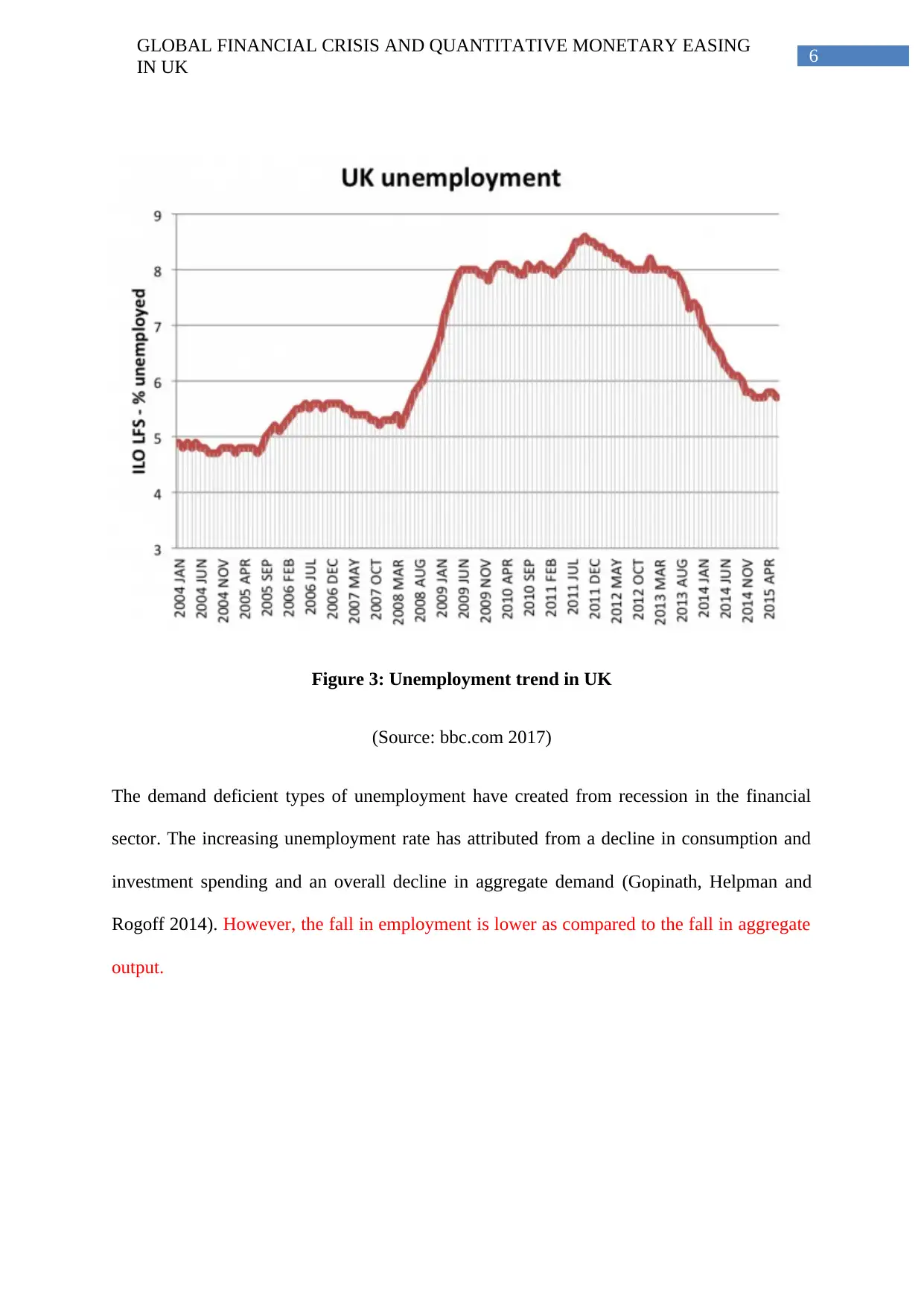
6
GLOBAL FINANCIAL CRISIS AND QUANTITATIVE MONETARY EASING
IN UK
Figure 3: Unemployment trend in UK
(Source: bbc.com 2017)
The demand deficient types of unemployment have created from recession in the financial
sector. The increasing unemployment rate has attributed from a decline in consumption and
investment spending and an overall decline in aggregate demand (Gopinath, Helpman and
Rogoff 2014). However, the fall in employment is lower as compared to the fall in aggregate
output.
GLOBAL FINANCIAL CRISIS AND QUANTITATIVE MONETARY EASING
IN UK
Figure 3: Unemployment trend in UK
(Source: bbc.com 2017)
The demand deficient types of unemployment have created from recession in the financial
sector. The increasing unemployment rate has attributed from a decline in consumption and
investment spending and an overall decline in aggregate demand (Gopinath, Helpman and
Rogoff 2014). However, the fall in employment is lower as compared to the fall in aggregate
output.
Paraphrase This Document
Need a fresh take? Get an instant paraphrase of this document with our AI Paraphraser
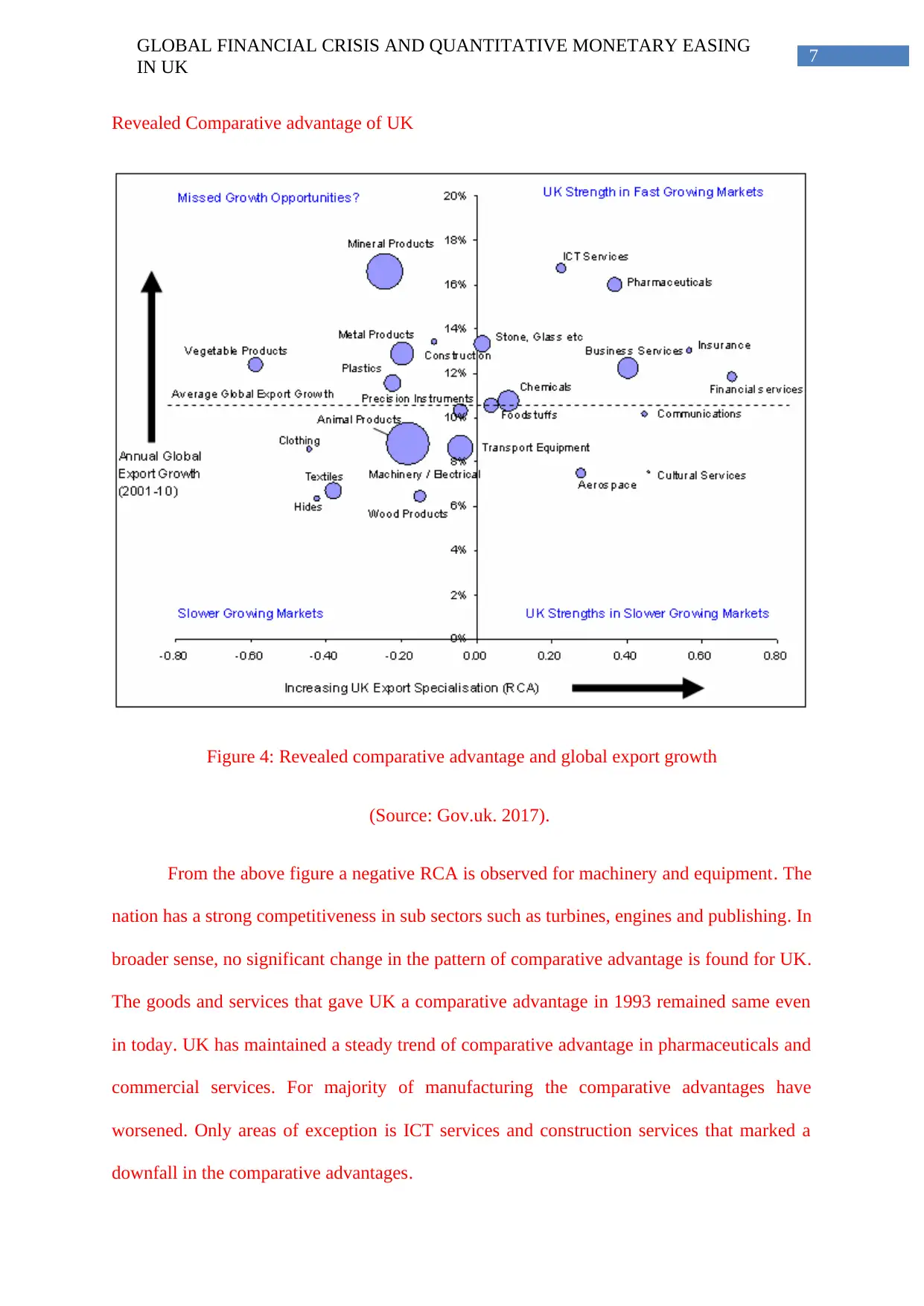
7
GLOBAL FINANCIAL CRISIS AND QUANTITATIVE MONETARY EASING
IN UK
Revealed Comparative advantage of UK
Figure 4: Revealed comparative advantage and global export growth
(Source: Gov.uk. 2017).
From the above figure a negative RCA is observed for machinery and equipment. The
nation has a strong competitiveness in sub sectors such as turbines, engines and publishing. In
broader sense, no significant change in the pattern of comparative advantage is found for UK.
The goods and services that gave UK a comparative advantage in 1993 remained same even
in today. UK has maintained a steady trend of comparative advantage in pharmaceuticals and
commercial services. For majority of manufacturing the comparative advantages have
worsened. Only areas of exception is ICT services and construction services that marked a
downfall in the comparative advantages.
GLOBAL FINANCIAL CRISIS AND QUANTITATIVE MONETARY EASING
IN UK
Revealed Comparative advantage of UK
Figure 4: Revealed comparative advantage and global export growth
(Source: Gov.uk. 2017).
From the above figure a negative RCA is observed for machinery and equipment. The
nation has a strong competitiveness in sub sectors such as turbines, engines and publishing. In
broader sense, no significant change in the pattern of comparative advantage is found for UK.
The goods and services that gave UK a comparative advantage in 1993 remained same even
in today. UK has maintained a steady trend of comparative advantage in pharmaceuticals and
commercial services. For majority of manufacturing the comparative advantages have
worsened. Only areas of exception is ICT services and construction services that marked a
downfall in the comparative advantages.
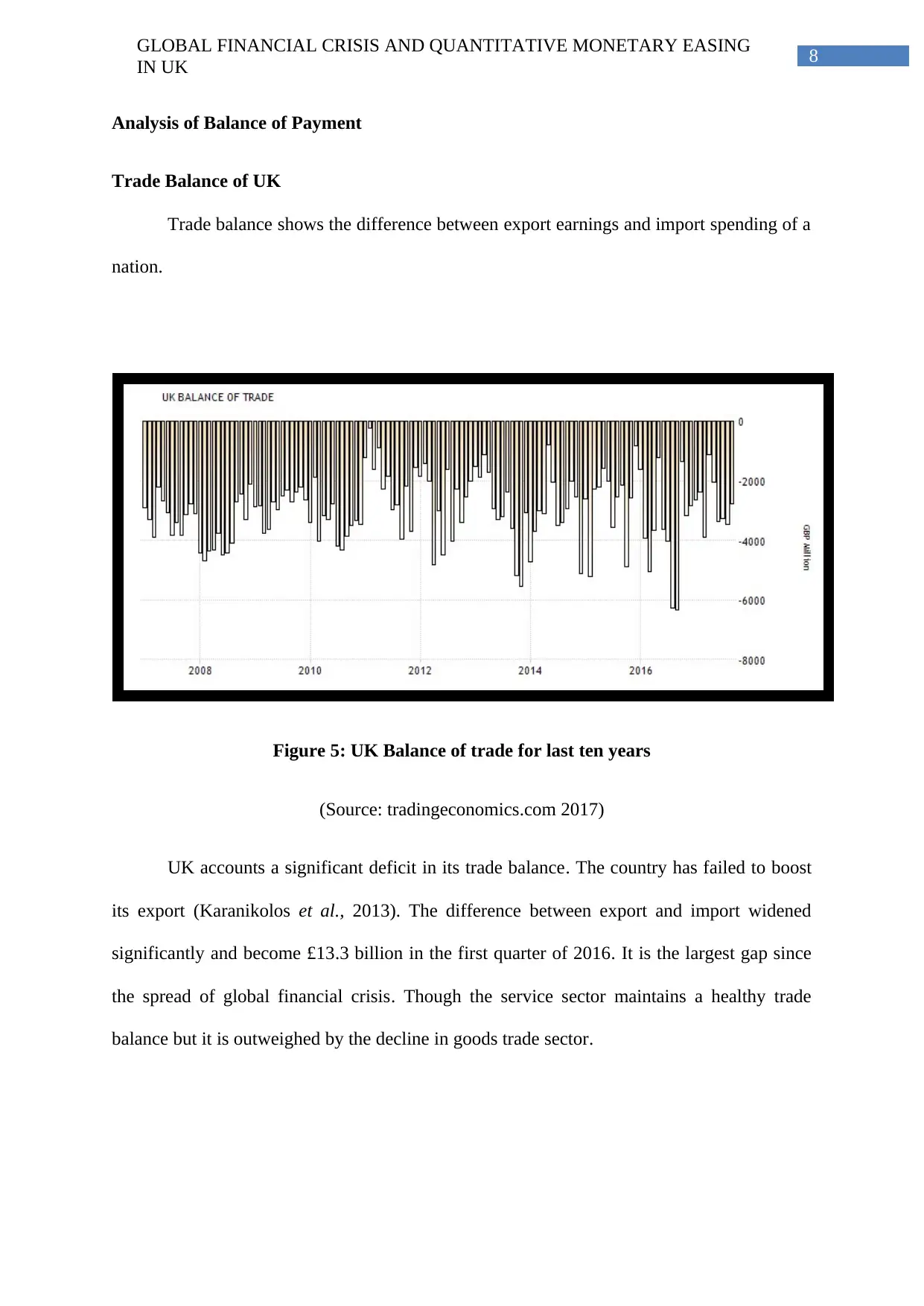
8
GLOBAL FINANCIAL CRISIS AND QUANTITATIVE MONETARY EASING
IN UK
Analysis of Balance of Payment
Trade Balance of UK
Trade balance shows the difference between export earnings and import spending of a
nation.
Figure 5: UK Balance of trade for last ten years
(Source: tradingeconomics.com 2017)
UK accounts a significant deficit in its trade balance. The country has failed to boost
its export (Karanikolos et al., 2013). The difference between export and import widened
significantly and become £13.3 billion in the first quarter of 2016. It is the largest gap since
the spread of global financial crisis. Though the service sector maintains a healthy trade
balance but it is outweighed by the decline in goods trade sector.
GLOBAL FINANCIAL CRISIS AND QUANTITATIVE MONETARY EASING
IN UK
Analysis of Balance of Payment
Trade Balance of UK
Trade balance shows the difference between export earnings and import spending of a
nation.
Figure 5: UK Balance of trade for last ten years
(Source: tradingeconomics.com 2017)
UK accounts a significant deficit in its trade balance. The country has failed to boost
its export (Karanikolos et al., 2013). The difference between export and import widened
significantly and become £13.3 billion in the first quarter of 2016. It is the largest gap since
the spread of global financial crisis. Though the service sector maintains a healthy trade
balance but it is outweighed by the decline in goods trade sector.
⊘ This is a preview!⊘
Do you want full access?
Subscribe today to unlock all pages.

Trusted by 1+ million students worldwide
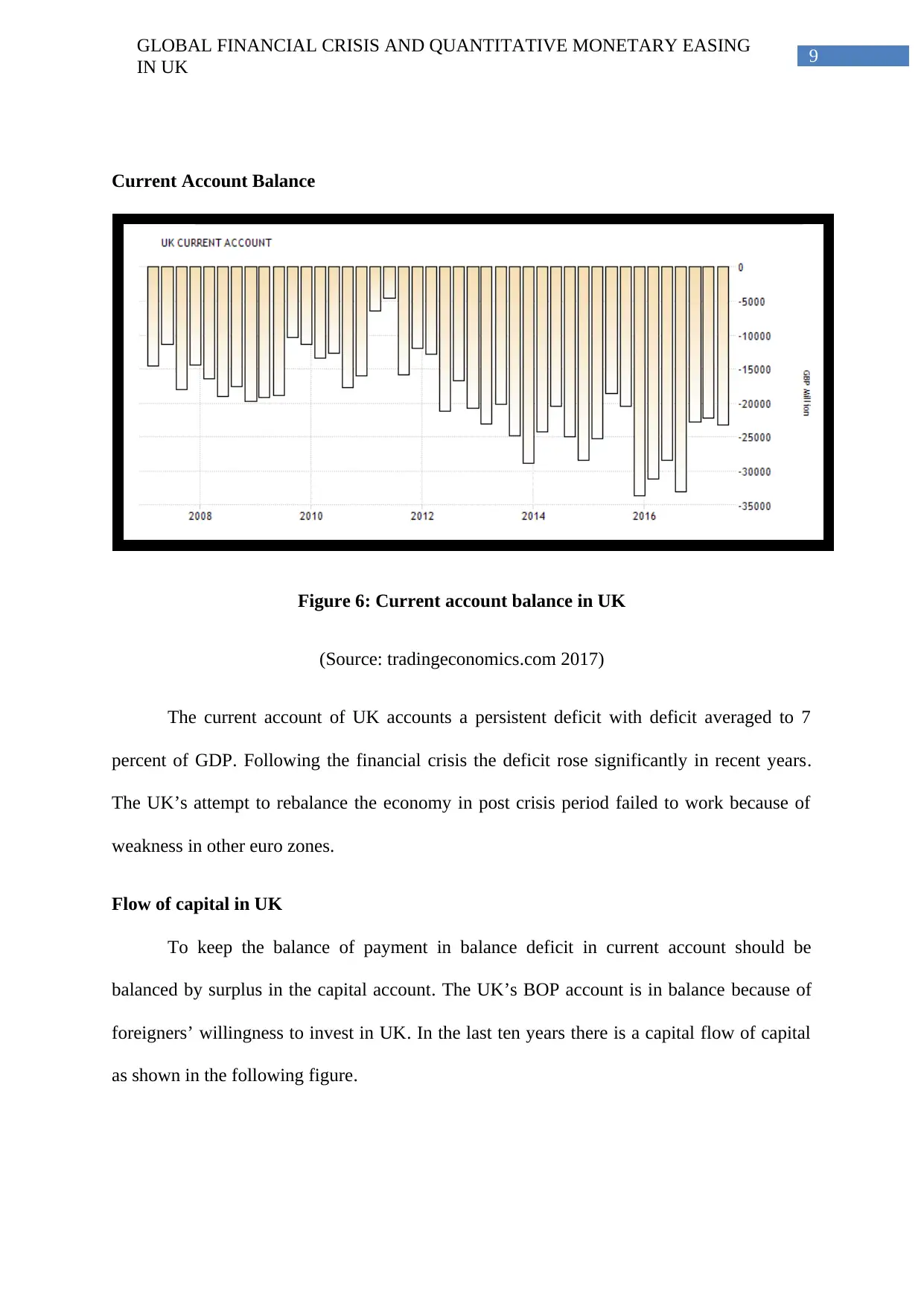
9
GLOBAL FINANCIAL CRISIS AND QUANTITATIVE MONETARY EASING
IN UK
Current Account Balance
Figure 6: Current account balance in UK
(Source: tradingeconomics.com 2017)
The current account of UK accounts a persistent deficit with deficit averaged to 7
percent of GDP. Following the financial crisis the deficit rose significantly in recent years.
The UK’s attempt to rebalance the economy in post crisis period failed to work because of
weakness in other euro zones.
Flow of capital in UK
To keep the balance of payment in balance deficit in current account should be
balanced by surplus in the capital account. The UK’s BOP account is in balance because of
foreigners’ willingness to invest in UK. In the last ten years there is a capital flow of capital
as shown in the following figure.
GLOBAL FINANCIAL CRISIS AND QUANTITATIVE MONETARY EASING
IN UK
Current Account Balance
Figure 6: Current account balance in UK
(Source: tradingeconomics.com 2017)
The current account of UK accounts a persistent deficit with deficit averaged to 7
percent of GDP. Following the financial crisis the deficit rose significantly in recent years.
The UK’s attempt to rebalance the economy in post crisis period failed to work because of
weakness in other euro zones.
Flow of capital in UK
To keep the balance of payment in balance deficit in current account should be
balanced by surplus in the capital account. The UK’s BOP account is in balance because of
foreigners’ willingness to invest in UK. In the last ten years there is a capital flow of capital
as shown in the following figure.
Paraphrase This Document
Need a fresh take? Get an instant paraphrase of this document with our AI Paraphraser
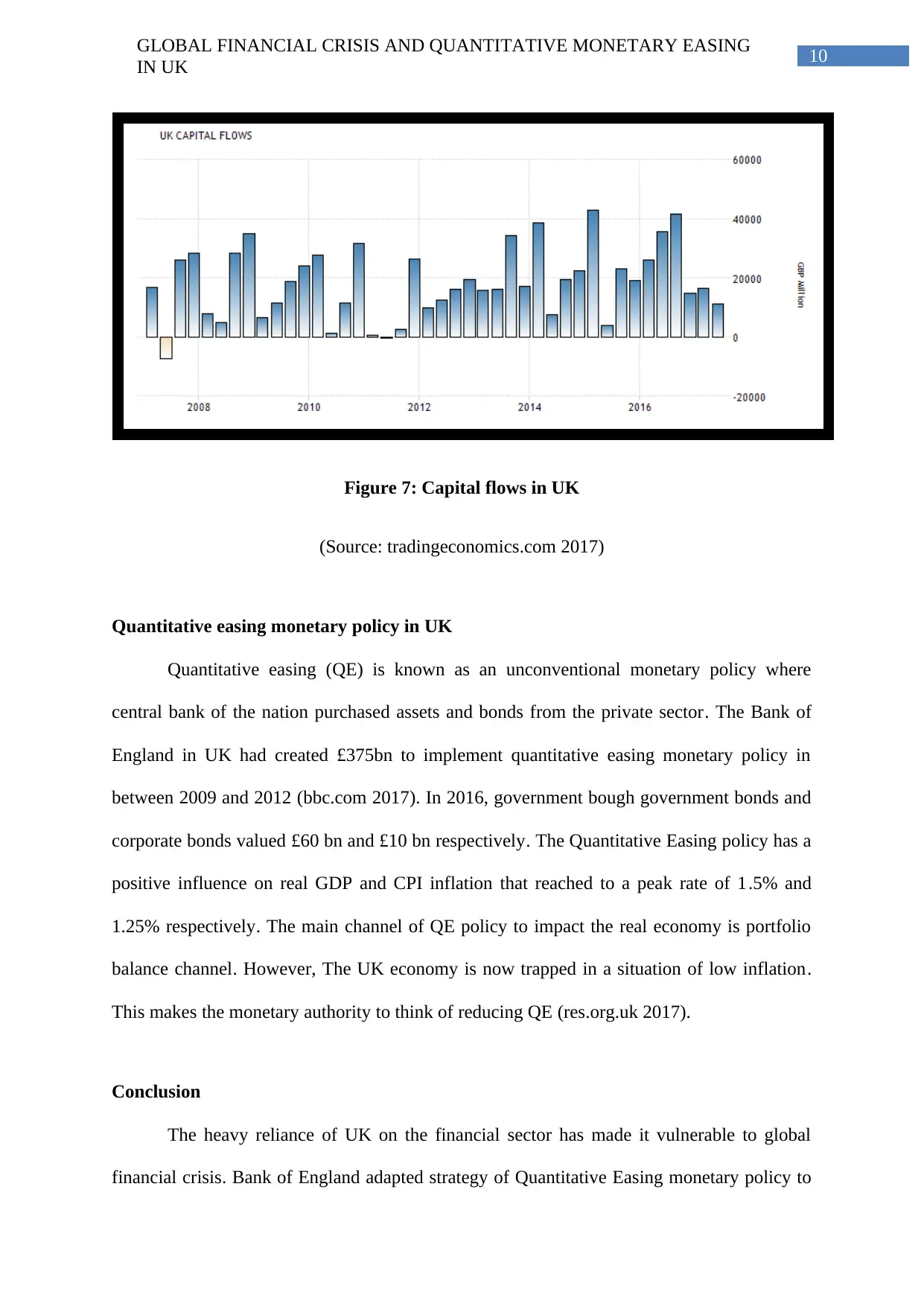
10
GLOBAL FINANCIAL CRISIS AND QUANTITATIVE MONETARY EASING
IN UK
Figure 7: Capital flows in UK
(Source: tradingeconomics.com 2017)
Quantitative easing monetary policy in UK
Quantitative easing (QE) is known as an unconventional monetary policy where
central bank of the nation purchased assets and bonds from the private sector. The Bank of
England in UK had created £375bn to implement quantitative easing monetary policy in
between 2009 and 2012 (bbc.com 2017). In 2016, government bough government bonds and
corporate bonds valued £60 bn and £10 bn respectively. The Quantitative Easing policy has a
positive influence on real GDP and CPI inflation that reached to a peak rate of 1.5% and
1.25% respectively. The main channel of QE policy to impact the real economy is portfolio
balance channel. However, The UK economy is now trapped in a situation of low inflation.
This makes the monetary authority to think of reducing QE (res.org.uk 2017).
Conclusion
The heavy reliance of UK on the financial sector has made it vulnerable to global
financial crisis. Bank of England adapted strategy of Quantitative Easing monetary policy to
GLOBAL FINANCIAL CRISIS AND QUANTITATIVE MONETARY EASING
IN UK
Figure 7: Capital flows in UK
(Source: tradingeconomics.com 2017)
Quantitative easing monetary policy in UK
Quantitative easing (QE) is known as an unconventional monetary policy where
central bank of the nation purchased assets and bonds from the private sector. The Bank of
England in UK had created £375bn to implement quantitative easing monetary policy in
between 2009 and 2012 (bbc.com 2017). In 2016, government bough government bonds and
corporate bonds valued £60 bn and £10 bn respectively. The Quantitative Easing policy has a
positive influence on real GDP and CPI inflation that reached to a peak rate of 1.5% and
1.25% respectively. The main channel of QE policy to impact the real economy is portfolio
balance channel. However, The UK economy is now trapped in a situation of low inflation.
This makes the monetary authority to think of reducing QE (res.org.uk 2017).
Conclusion
The heavy reliance of UK on the financial sector has made it vulnerable to global
financial crisis. Bank of England adapted strategy of Quantitative Easing monetary policy to
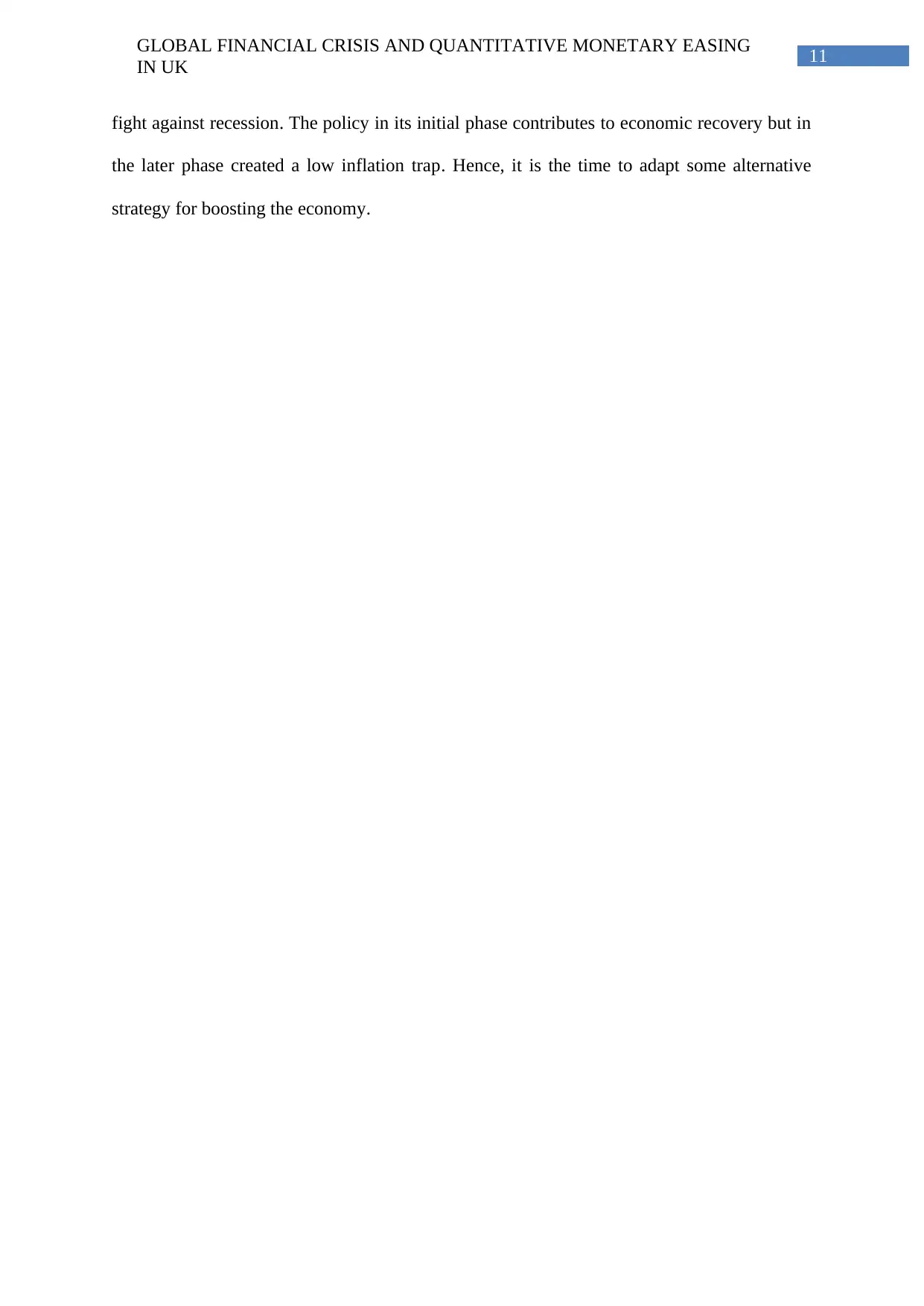
11
GLOBAL FINANCIAL CRISIS AND QUANTITATIVE MONETARY EASING
IN UK
fight against recession. The policy in its initial phase contributes to economic recovery but in
the later phase created a low inflation trap. Hence, it is the time to adapt some alternative
strategy for boosting the economy.
GLOBAL FINANCIAL CRISIS AND QUANTITATIVE MONETARY EASING
IN UK
fight against recession. The policy in its initial phase contributes to economic recovery but in
the later phase created a low inflation trap. Hence, it is the time to adapt some alternative
strategy for boosting the economy.
⊘ This is a preview!⊘
Do you want full access?
Subscribe today to unlock all pages.

Trusted by 1+ million students worldwide
1 out of 14
Related Documents
Your All-in-One AI-Powered Toolkit for Academic Success.
+13062052269
info@desklib.com
Available 24*7 on WhatsApp / Email
![[object Object]](/_next/static/media/star-bottom.7253800d.svg)
Unlock your academic potential
Copyright © 2020–2025 A2Z Services. All Rights Reserved. Developed and managed by ZUCOL.





